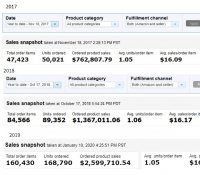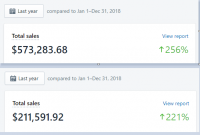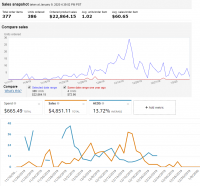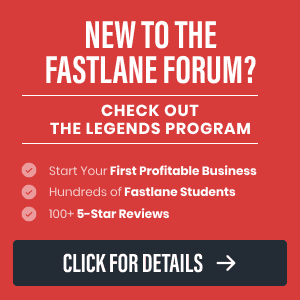The purpose of this thread is to present real, concrete facts and numbers on why starting a business on Amazon might be the absolute dumbest, lowest ROI thing you could do. It's not based on anecdotes. It's not based on hypotheticals. It's based around numbers published by one of the most pro-Amazon sites out there: JungleScout. However, instead of presenting it the way JungleScout wants to, I'll break down the numbers into what they really mean.
A quick summary: The average person fails at Amazon. Of those that succeed, the average person makes $9,000 a year at $10 per hour. To get there, they invest 10+ months of their time, and $4,000. Amazon has reached the point of "Uber" where it has misled people into believing that they're starting a real business that's generating real returns - when in reality the average seller is slaving away at $10 per hour.
In later posts, feel free to share theories and anecdotes. The Amazon-brainwashed crowd, feel free to post emotional responses and select anecdotes. In this post, I'll dive right into the numbers.
Before we begin, let me note the inspiration for this thread: @jpanarra's "New Sellers Earn Between $26,000 To $810,000 Per Year In Profit" - a thread based around data that was taken from the following primary source: How Much Money Do Amazon Sellers Make? | Jungle Scout. I was originally going to write a quick reply to his post, but as I started looking at the language and numbers, I started breaking them down and noticed exactly how bad they really were. That's how this thread was born. If the language is a little off, note that it was originally intended as a reply before the data became valuable enough to make its own thread.
So let's get to it.
First, let's start with the note that the data is published by JungleScout - whose primary incentive is to get more people selling on Amazon. Next, let's look at exactly who the data is based on:
"Between November 14 and December 10, 2019, Jungle Scout surveyed 2,063 Amazon sellers about their experiences. This article references responses from 1,046 experienced Amazon sellers who have more than a year of selling experience and at least one live product listing."
These guys literally surveyed 2,063 people. Decided that half of them suck and don't support their findings. Tossed them out, and kept only half the responses, 1,046 sellers that had attained "some" success.
Why?
Because the 1,017 others didn't fit their narrative and PR push.
If you look at what that actually means, it means that over 50% of preselected Amazon sellers (that were serious enough to have a JungleScout account), fared worse than the data that will be presented below. Add to that all the people without a js account, all the people that have already failed, or those that will fail, and you're left with a very high percentage of sellers that have been huge disappointments.
Of the 50% left, they further fudged the numbers using misleading statements and improper calculations. Let's start with an example of one of those statements:
This statement at face value looks impressive. Here's what it actually means:
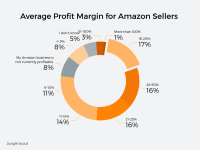
Using the chart above, it means that the median profit margin per Amazon seller is 15% (and note: I said MEDIAN, not "average" or some bullshit that Jungle Scout will use to change perception). That's from the product. Not net after including R&D, branding, EMPLOYEE costs, and all other costs. If you factor in those costs, then the true net margin will be a lot lower.
Is that still impressive? Could be. But is it as impressive as the statement that they built around the data? Definitely not.
Next, let's see how they present sales numbers:
Another quote that seems incredibly impressive. In reality, far from it.
That's what the article presents for sales numbers. Let's see what these numbers actually mean in terms of sales percentiles based on this statement:
To dive deeper, luckily for us, JungleScout was naive enough to publish their full data:
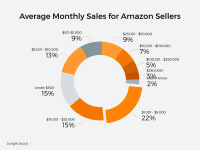
So using this info, we can continue and break down the data even more into what it actually means:
2% don't know their sales, so we'll just add them into the lower tier group (likely wantrepreneurs), making the rest of the percentiles as follows:
If you don't understand managerial or financial accounting, then you'll assume that the number is good. Afterall, the average person doesn't "make" $5,000 at their job every month. Amazon has to be the way. Or does it. We have to ask the next question...
So what's that mean in terms of profit per year? Not sales, but profit.
If we use JungleScout's bullshit metric, then that's a ton of money. If we use the median profit margin of 15% (which it is according to the chart above), then here's what that means:
And I know you wantrepreneurs will say "Yeah, but look at the top brackets, those guys are killing it". Yeah, they are, but how much are they spending on employees?
Those guys that are doing $450,000 gross per year? How many employees do you think they have? And how much money do you think they're actually putting into their pocket end of the year? I won't answer this question since there's too much variability, however I will give you concrete data for the next point.
"Ok, so $9,000 a year. That would help me a lot with my life. How much do I have to work in order to make that money?"
Here's the breakdown from Junglescout:
The average person works 18 hours per week on their Amazon "business" to make $9,000 a year. Still worth it?
Let's break that down per hour:
18 hours per week * 50 weeks [two vacation weeks] = 900 hours per year.
$9,000 / 900 hours = $10 per hour.
The average "successful" seller works at $10 per hour to make $9,000 per year.
But wait... that's not all folks. There's also a startup cost!
You have to research Amazon, learn the Amazon skill sets, learn how to import, pay for courses, samples, moulds, manufacturing costs for products that you'll mess up and have to throw out, etc.
That all takes money and time.
How much money and time? Here's the breakdown from JungleScout:
They asked their sellers "How long does it take to become profitable on Amazon?":
Disappointed?
Let me disappoint you further.
Here's the data set when looking solely at people that started selling in 2018 and 2019:
Oh, and to add even more salt: the data above doesn't include sample, research, or studying time, the entire wantrepreneur phase where you're taking courses and reading threads on the fastlane forum.
And note: "Time to be profitable" can otherwise be written as "Time to stop losing money". Because that's what it really is. It takes the average person ten months to stop losing money on top of whatever they spent on courses.
So how much money do people "invest" to get started on Amazon?
Here's how much JungleScout users spent:
The median person spent about $4,000 to get started selling on Amazon.
So all in all, using JungleScout's data...
The average seller spends $4,000 and 10+ months to get started on Amazon. Once they're up and running, they can expect to make $9,000 a year at $10 per hour. From that, they have to subtract out employee costs, and other expenses, likely netting them a lot less.
Oh ... and that's if you're successful. If you're in the 50%+ category of people that JungleScout deleted from its "data set", then just expect to lose money altogether.
Amazon still sound cool? @MJ DeMarco
A quick summary: The average person fails at Amazon. Of those that succeed, the average person makes $9,000 a year at $10 per hour. To get there, they invest 10+ months of their time, and $4,000. Amazon has reached the point of "Uber" where it has misled people into believing that they're starting a real business that's generating real returns - when in reality the average seller is slaving away at $10 per hour.
In later posts, feel free to share theories and anecdotes. The Amazon-brainwashed crowd, feel free to post emotional responses and select anecdotes. In this post, I'll dive right into the numbers.
Before we begin, let me note the inspiration for this thread: @jpanarra's "New Sellers Earn Between $26,000 To $810,000 Per Year In Profit" - a thread based around data that was taken from the following primary source: How Much Money Do Amazon Sellers Make? | Jungle Scout. I was originally going to write a quick reply to his post, but as I started looking at the language and numbers, I started breaking them down and noticed exactly how bad they really were. That's how this thread was born. If the language is a little off, note that it was originally intended as a reply before the data became valuable enough to make its own thread.
So let's get to it.
First, let's start with the note that the data is published by JungleScout - whose primary incentive is to get more people selling on Amazon. Next, let's look at exactly who the data is based on:
"Between November 14 and December 10, 2019, Jungle Scout surveyed 2,063 Amazon sellers about their experiences. This article references responses from 1,046 experienced Amazon sellers who have more than a year of selling experience and at least one live product listing."
These guys literally surveyed 2,063 people. Decided that half of them suck and don't support their findings. Tossed them out, and kept only half the responses, 1,046 sellers that had attained "some" success.
Why?
Because the 1,017 others didn't fit their narrative and PR push.
If you look at what that actually means, it means that over 50% of preselected Amazon sellers (that were serious enough to have a JungleScout account), fared worse than the data that will be presented below. Add to that all the people without a js account, all the people that have already failed, or those that will fail, and you're left with a very high percentage of sellers that have been huge disappointments.
Of the 50% left, they further fudged the numbers using misleading statements and improper calculations. Let's start with an example of one of those statements:
"For 67.2% of the sellers, the profit margin is more than 10%. If that is not impressive enough, 36% see profit margins above 20%."
This statement at face value looks impressive. Here's what it actually means:
- 32.8% of sellers make between 0-10%
- 31.2% of sellers make between 10-20%
- 36% of sellers making profit margins above 20%

Using the chart above, it means that the median profit margin per Amazon seller is 15% (and note: I said MEDIAN, not "average" or some bullshit that Jungle Scout will use to change perception). That's from the product. Not net after including R&D, branding, EMPLOYEE costs, and all other costs. If you factor in those costs, then the true net margin will be a lot lower.
Is that still impressive? Could be. But is it as impressive as the statement that they built around the data? Definitely not.
Next, let's see how they present sales numbers:
"A little over half or 50.7% make from $1,000-$25,000/month. In terms of annual sales, it can mean anywhere from $12,000-$300,000.
Another one in five (20%) make $25,000 – $250,000/month, totaling annual sales between $300,000 and $3,000,000. But there is another small group (3.3%) making more than $250,000 in monthly sales.
On the lower side of the earning scale, 23.8% of sellers make less than $1,000 per month, with 2.1% not knowing how much they make."
Another quote that seems incredibly impressive. In reality, far from it.
That's what the article presents for sales numbers. Let's see what these numbers actually mean in terms of sales percentiles based on this statement:
- 0 percentile: Lose money
- 24th percentile: $1,000 in sales per month
- 80th percentile: $25,000 in sales per month
- 99.9th percentile: $250,000 in sales per month
To dive deeper, luckily for us, JungleScout was naive enough to publish their full data:

So using this info, we can continue and break down the data even more into what it actually means:
2% don't know their sales, so we'll just add them into the lower tier group (likely wantrepreneurs), making the rest of the percentiles as follows:
- 0-17th percentile: Make under $500 in sales (aka - lose money)
- 17-26th percentile: $500 to $1,000 in sales
- 26-48th percentile: $1,000 to $5,000 in sales
- 48-61st percentile: $5,000 to $10,000 in sales
- 61-76th percentile: $10,000 to $25,000 in sales
- 76-85th percentile: $25,000 to $50,000 in sales
- 85-92nd percentile: $50,000 to $100,000 in sales
- 92-97th percentile: $100,000 to $250,000 in sales
- 97-99.9th percentile: $250,000+ in sales
If you don't understand managerial or financial accounting, then you'll assume that the number is good. Afterall, the average person doesn't "make" $5,000 at their job every month. Amazon has to be the way. Or does it. We have to ask the next question...
So what's that mean in terms of profit per year? Not sales, but profit.
If we use JungleScout's bullshit metric, then that's a ton of money. If we use the median profit margin of 15% (which it is according to the chart above), then here's what that means:
- 0-17th percentile: Lose money a year.
- 17-26th percentile: $900 to $1,800 in GROSS profit per year
- 26-48th percentile: $1,800 to $9,000 in GROSS profit per year
- 48-61st percentile: $9,000 to $18,000 in GROSS profit per year
- 61-76th percentile: $18,000 to $45,000 in GROSS profit per year
- 76-85th percentile: $45,000 to $90,000 in GROSS profit per year
- 85-92nd percentile: $90,000 to $180,000 in GROSS profit per year
- 92-97th percentile: $180,000 to $450,000 in GROSS profit per year
- 97-99.9th percentile: $450,000+ in GROSS profit per year
And I know you wantrepreneurs will say "Yeah, but look at the top brackets, those guys are killing it". Yeah, they are, but how much are they spending on employees?
Those guys that are doing $450,000 gross per year? How many employees do you think they have? And how much money do you think they're actually putting into their pocket end of the year? I won't answer this question since there's too much variability, however I will give you concrete data for the next point.
"Ok, so $9,000 a year. That would help me a lot with my life. How much do I have to work in order to make that money?"
Here's the breakdown from Junglescout:
- Fewer than 4 hours per week: 13%
- 4-10 hours: 24%
- 11-20 hours: 20%
- 21-30 hours: 15%
- 31-40 hours: 10%
- 41-50 hours: 9%
- 51-60 hours: 3%
- More than 60 hours: 6%
- 0-13th percentile: 0-4 hours per week
- 13-37th percentile: 4-10 hours per week
- 37-57th percentile: 11-20 hours per week
- 57-72nd percentile: 21-30 hours per week
- 72-82nd percentile: 31 to 40 hours per week
- 82-91st percentile: 41-50 hours per week
- 91-94th percentile: 51-60 hours per week
- 94-99.9th percentile: 60 hours + plus week
The average person works 18 hours per week on their Amazon "business" to make $9,000 a year. Still worth it?
Let's break that down per hour:
18 hours per week * 50 weeks [two vacation weeks] = 900 hours per year.
$9,000 / 900 hours = $10 per hour.
The average "successful" seller works at $10 per hour to make $9,000 per year.
But wait... that's not all folks. There's also a startup cost!
You have to research Amazon, learn the Amazon skill sets, learn how to import, pay for courses, samples, moulds, manufacturing costs for products that you'll mess up and have to throw out, etc.
That all takes money and time.
How much money and time? Here's the breakdown from JungleScout:
They asked their sellers "How long does it take to become profitable on Amazon?":
- Profits within 3 months: 22%
- Profits within 3-6 months: 22%
- Profits within 6 months-1 year: 23%
- Profits within 1-2 years: 13%
- Profits within more than 2 years: 3%
Disappointed?
Let me disappoint you further.
Here's the data set when looking solely at people that started selling in 2018 and 2019:
- Profits within 3 months: 16%
- Profits within 3-6 months: 23%
- Profits within 6 months-1 year: 24%
Oh, and to add even more salt: the data above doesn't include sample, research, or studying time, the entire wantrepreneur phase where you're taking courses and reading threads on the fastlane forum.
And note: "Time to be profitable" can otherwise be written as "Time to stop losing money". Because that's what it really is. It takes the average person ten months to stop losing money on top of whatever they spent on courses.
So how much money do people "invest" to get started on Amazon?
Here's how much JungleScout users spent:
- Sellers spent less than $500: 17%
- $500-1,000: 12%
- $1,001-2,500: 13%
- $2,501-5,000: 18%
- $5,001-10,000: 21%
- More than $10,000: 21%
The median person spent about $4,000 to get started selling on Amazon.
So all in all, using JungleScout's data...
The average seller spends $4,000 and 10+ months to get started on Amazon. Once they're up and running, they can expect to make $9,000 a year at $10 per hour. From that, they have to subtract out employee costs, and other expenses, likely netting them a lot less.
Oh ... and that's if you're successful. If you're in the 50%+ category of people that JungleScout deleted from its "data set", then just expect to lose money altogether.
Amazon still sound cool? @MJ DeMarco
Dislike ads? Remove them and support the forum:
Subscribe to Fastlane Insiders.
